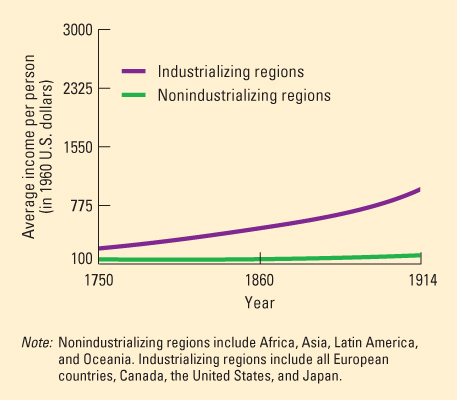The Rise of Global Inequality

FIGURE 25.1 The Growth of Average Income per Person Worldwide, 1750–1914 (Source of data: P. Bairoch and M. Lévy-Leboyer, eds., Disparities in Economic Development Since the Industrial Revolution, published 1981, Macmillan Publishers.)
From a global perspective, the ultimate significance of the Industrial Revolution was that it allowed those world regions that industrialized in the nineteenth century to increase their wealth and power enormously in comparison with those that did not. A gap between the industrializing regions (Europe, North America, Japan) and the nonindustrializing regions (mainly Africa, Asia, and Latin America) opened and grew steadily throughout the nineteenth century (Figure 25.1). Moreover, this pattern of uneven global development became institutionalized, built into the structure of the world economy. Thus evolved a world of economic haves and have-nots, with the have-not peoples and nations far outnumbering the haves.
In 1750 the average living standard was no higher in Europe as a whole than in the rest of the world. By 1914 the average person in the wealthiest countries had an income four or five times as great (and in Great Britain nine or ten times as great) as an average person’s income in the poorest countries of Africa and Asia. The rise in average income and well-being reflected the rising level of industrialization in Great Britain and then in the other developed countries before World War I.
The reasons for these enormous income disparities, which are poignant indicators of disparities in food and clothing, health and education, life expectancy, and general material well-being, have generated a great deal of debate. One school of interpretation stresses that the West used science, technology, capitalist organization, and even its critical worldview to create its wealth and greater physical well-being. An opposing school argues that the West used its political, economic, and military power to steal much of its riches through its rapacious colonialism in the nineteenth and twentieth centuries.
These issues are complex, and there are few simple answers. As noted in Chapter 23, the wealth-creating potential of technological improvement and more intensive capitalist organization was great. At the same time, the initial breakthroughs in the late eighteenth century rested in part on Great Britain’s having already used political force to dominate a substantial part of the world economy. In the nineteenth century other industrializing countries joined with Britain to extend Western dominion over the entire world economy. Unprecedented wealth was created, but the lion’s share of that new wealth flowed to the West and its propertied classes and to a tiny indigenous elite of cooperative rulers, landowners, and merchants.
